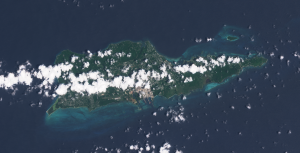
The US virgin Islands as seen from ESA’s Sentinel-2 satellite on 23rd August 2017.
To some, astronomy is a purely a curiosity-driven activity, trying to understand more about the Universe around us. While that is the primary reason for a great many astronomers, there are many ways in which it benefits life down hear on Earth – including the saving of lives.
Most recently, this became relevant in the late summer 2017, when s a number of hurricanes and storms hit the Caribbean and east coast of the the United States. Using satellite imagery, combined with techniques first developed for studying supernovae, Dr Brooke Simmons worked with astronomers and developers at the Zooniverse to create the Planetary Response Network, an online portal that allows people all over the world to guide the disaster recovery teams, particularly in regions with poor infrastructure. This month, Chris North spoke to Brooke about the development of the Planetary Response Network and its impact on the rescue efforts.
But first, since this is the last episode of 2017, Chris and Edward Gomez reviewed progress in astronomy throughout 2017, from exoplanets to colliding neutron stars.
An extended edition of original broadcasts on 27th December 2017 and 3rd January 2018 as part of Pythagoras’ Trousers on Radio Cardiff.
For an archive of Pythagorean Astronomy, visit pythagastro.uk.





